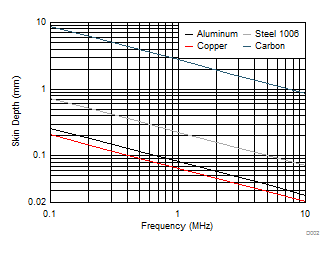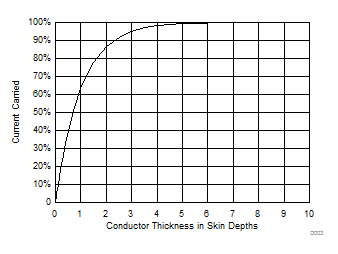SNOA957B September 2016 – June 2021 LDC0851 , LDC1001 , LDC1001-Q1 , LDC1041 , LDC1051 , LDC1101 , LDC1312 , LDC1312-Q1 , LDC1314 , LDC1314-Q1 , LDC1612 , LDC1612-Q1 , LDC1614 , LDC1614-Q1 , LDC2112 , LDC2114 , LDC3114 , LDC3114-Q1
2.2 Skin Depth
Like all AC currents, the eddy currents induced by the LDC’s AC magnetic field flow near the surface of the conductor, and reduce in amplitude deeper into the conductor. The attenuation of current follows an exponential trend with distance from the surface. The skin depth, δ, is the distance at which the current is reduced to 1/e (~37%) of the density at the surface. Every additional increase of δ from surface will see an additional 1/e reduction in current.
For highly conductive materials, such as metals, the skin depth δs can be calculated by:

where
- μ is the magnetic permeability of the material, which is μo (4π×10-7) multiplied by the conductor’s relative permeability,
- ρ is the resistivity of the conductor, and
- f is the frequency of the AC magnetic field.
Skin depth varies with the material and sensor frequency. At higher frequencies, the skin depth becomes smaller and smaller, which results in the eddy currents concentrating at the surface of the conductor. Poorer conductors, such as carbon, have a larger value for their skin depth, as shown in Figure 2-5. Poorly conductive materials have a limit on skin depth; as an example, silicon never gets below 11 m.
 Figure 2-5 Skin Depth vs. Frequency for a Variety of Conductors
Figure 2-5 Skin Depth vs. Frequency for a Variety of ConductorsA conductor with a thickness equal to 1 skin depth for a given frequency will carry 63.2% of the current of an infinitely thick conductor. With a conductor of 3 skin depths thick, 95% of the total current will be induced, as shown in Figure 2-6.
To achieve best performance, a good rule of thumb is to that the target thickness should be at least 2 to 3 skin depths. To achieve this, either increase the target thickness or sensor frequency.
 Figure 2-6 Current vs. Conductor Skin Depth
Figure 2-6 Current vs. Conductor Skin Depth